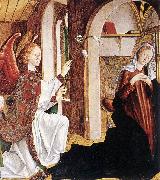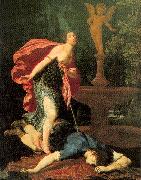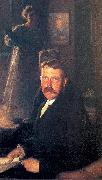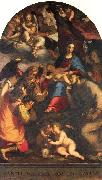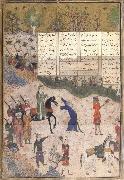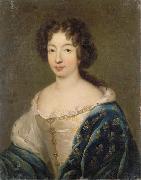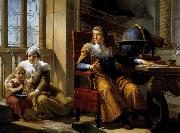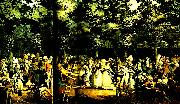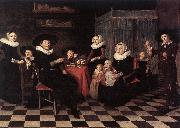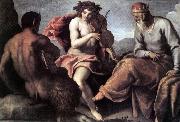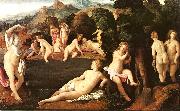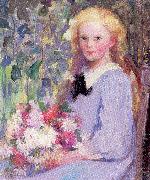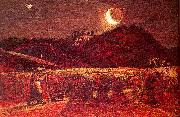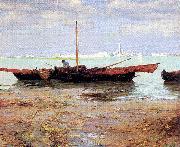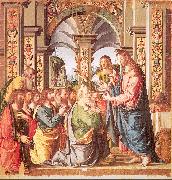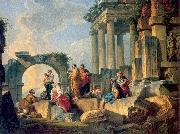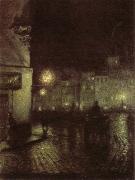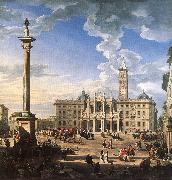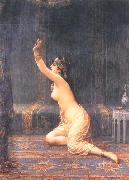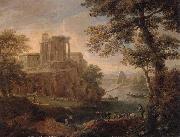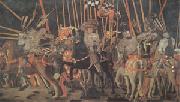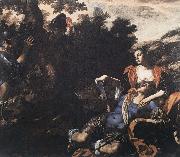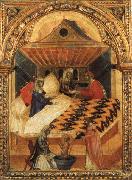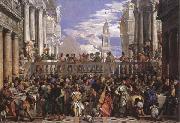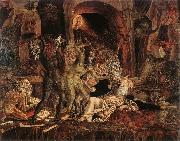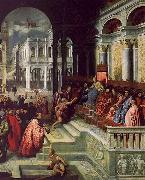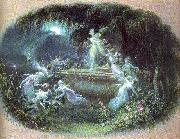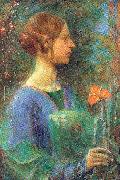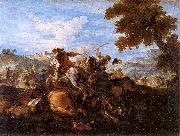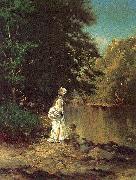|
|
 |
pablo casals
|
|
Catalan cellist and composer. He studied at Barcelona from 1887 and made his d??but there in 1891. After further study in Madrid and Brussels his international career began in 1899, when he played Lalos Concerto under Lamoureux in Paris. In 1905 he formed a trio with Thibaud and Cortot, recording works by Schubert and Beethoven. As a soloist Casals was renowned for his beautiful tone and intellectual strength. His playing did much to bring Bach's suites into the repertory. He formed the Orquestra Pau Casals in Barcelona in 1919 but his activities were curtailed by the Spanish Civil War. In 1950 at Prades he returned to music-making and later directed festivals at Perpignan and Puerto Rico. His many pupils included Guilhermina Suggia, with whom he formed a liaison. Casals wrote instrumental works and many choral pieces of a simple, devotional nature. |
|
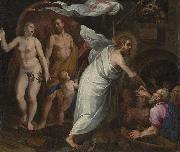 |
Pablo de Cespedes
|
|
(1538 - July 26, 1608) was a Spanish painter, poet, and architect.
His father, Alonso Cespedes, was descended of a noble Castilian family, once settled at Ocaña, and the name of his mother, who was a native of Alcolea de Torote, was Olaya de Arroya. Pablo was born and brought up in the house of his father's maternal uncle, Francisco Lopez de Aponte, Canon of Cordoba, where he received a learned education. At the age of eighteen, in 1556, he was sent to the Universidad Complutense in Alcale de Henares, and there, devoted himself to the acquirement of Oriental languages and theology. He later moved to Rome where he studied painting under Federico Zuccari.
He was in Rome in February 1559, engaged in conducting certain negotiations for the Archbishop Carranza de Miranda, of Toledo, who then stood charged with heresy before the Inquisition of Valladolid. On the 17th of that month he addressed a letter to the prelate, informing him how his business stood at the Vatican, in which he incautiously reflected on the conduct of the Inquisitor-General Valdez, and the Holy Officeean offence which no Inquisitor-General would forgive. This document and others were seized with the primate's papers; he was therefore denounced by the tribunal, and but for his fortunate absence, would have been imprisoned. It is probable that he did not venture back into Spain for many years, until he had covered his sins with the protecting robes of the Church.
He remained in Italy for over 20 years and built a reputation as an artist. His only surviving works from that period are the frescoes he painted in the Bonfili chapel at the Santa Trinite dei Monti church in Rome.
He returned to Spain in 1577, and was appointed as the canon of the Cerdoba cathedral. He continued to write books on antiquarian topics such as the architecture of the temple of Solomon. He befriended Arias Montano. In 1604 he composed his Discourse of Ancient and Modern Painting and Sculpture in which he recounts anecdotes of Renaissance masters of Italy.
|
|
|
|
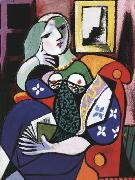 |
pablo picasso
|
|
Pablo Diego Josee Francisco de Paula Juan Nepomuceno Mareea de los Remedios Cipriano de la Sant??sima Trinidad Martyr Patricio Clito Rueez y Picasso (25 October 1881 C 8 April 1973) was an Andalusian-Spanish painter, draughtsman, and sculptor. As one of the most recognized figures in twentieth-century art, he is best known for co-founding the Cubist movement and for the wide variety of styles embodied in his work. Among his most famous works are the proto-Cubist Les Demoiselles d Avignon (1907) and his depiction of the German bombing of Guernica during the Spanish Civil War, Guernica (1937).
Picasso was baptized Pablo Diego Josee Francisco de Paula Juan Nepomuceno Mareea de los Remedios Cipriano de la Santesima Trinidad Clito, a series of names honouring various saints and relatives. Added to these were Rueez and Picasso, for his father and mother, respectively, as per Spanish custom. Born in the city of Melaga in the Andalusian region of Spain, he was the first child of Don Josee Ruiz y Blasco (1838?C1913) and Marea Picasso y Lepez. Picassoes family was middle-class; his father was also a painter who specialized in naturalistic depictions of birds and other game. For most of his life Ruiz was a professor of art at the School of Crafts and a curator of a local museum. Ruizes ancestors were minor aristocrats.
The young Picasso showed a passion and a skill for drawing from an early age; according to his mother, his first words were epiz, pize, a shortening of lepiz, the Spanish word for epencile. From the age of seven, Picasso received formal artistic training from his father in figure drawing and oil painting. Ruiz was a traditional, academic artist and instructor who believed that proper training required disciplined copying of the masters, and drawing the human body from plaster casts and live models. His son became preoccupied with art to the detriment of his classwork.
The family moved to La Coruna in 1891 so his father could become a professor at the School of Fine Arts. They stayed almost four years. On one occasion the father found his son painting over his unfinished sketch of a pigeon. Observing the precision of his sones technique, Ruiz felt that the thirteen-year-old Picasso had surpassed him, and vowed to give up painting.
In 1895, Picasso seven-year old sister, Conchita, died of diphtheria - a traumatic event in his life.After her death, the family moved to Barcelona, with Ruiz transferring to its School of Fine Arts. Picasso thrived in the city, regarding it in times of sadness or nostalgia as his true home. Ruiz persuaded the officials at the academy to allow his son to take an entrance exam for the advanced class. This process often took students a month, but Picasso completed it in a week, and the impressed jury admitted Picasso, who was still 13. The student lacked discipline but made friendships that would affect him in later life. His father rented him a small room close to home so Picasso could work alone, yet Ruiz checked up on him numerous times a day, judging his sones drawings. The two argued frequently.
Picassoes father and uncle decided to send the young artist to Madrides Royal Academy of San Fernando, the foremost art school in the country. In 1897, Picasso, age 16, set off for the first time on his own. Yet his difficulties accepting formal instruction led him to stop attending class soon after enrollment. Madrid, however, held many other attractions: the Prado housed paintings by the venerable Diego Velezquez, Francisco Goya, and Francisco Zurbaren. Picasso especially admired the works of El Greco; their elements, like elongated limbs, arresting colors, and mystical visages, are echoed in Picassoes œuvre.
|
|
|
|
|
|
|
|
|
|
|
|
|
|
|
|
|
|
|
|
|
|
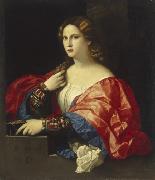 |
Palma il Vecchio
|
|
(c. 1480 - July 1528), born Jacopo Palma or known as Jacopo Negretti, was an Italian painter of the Venetian school born at Serina Alta near Bergamo. He is called Palma Vecchio in English ("Old Palma" - in Italian Palma il Vecchio) to distinguish him from Palma Giovane, his great-nephew.
When Palma arrived in Venice early in the 16th century, he reputedly was a companion and competitor of Lorenzo Lotto, and to some extent a pupil of Titian. He may also have taught Bonifazio Pitati and influenced Giovanni Busi. Palma's earlier works betray the influence of the Bellini. |
|
|
|
|
|
|
|
|
|
|
|
|
|
 |
Pandolfo Reschi
|
|
(b Gdansk, c. 1640; d Florence, 1696).
Polish painter, active in Italy |
|
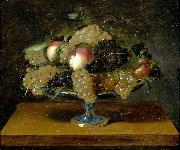 |
Panfilo Nuvolone
|
|
(1581-1651) was an Italian painter of the Mannerist period, who painted both religious and still life topics, active in Cremona and Mantua.
Born to a Mantuan gentleman, he was the father of a family of Cremonese painters. In that town, he apprenticed with Giovanni Battista Trotti (known as il Malosso). Afterwards he moved to Milan, where frescoe church ceilings, and painted altarpieces and still lifes.
One of his few documented still lifes depict a bowl of peaches, and recalls the near-contemporary paintings of fruit bowls in Milan, including the 1594-98 painting in the Ambrosiana by Caravaggio and similarly themed paintings by Fede Galizia. His son, Carlo Francesco Nuvolone, also a prominent in painter in Lombardy. Panfilo's younger son Giuseppe Nuvolone also a painter. Giuseppe's son Carlo was a mediocre quadratura specialist active mainly around Cremona. |
|
|
|
|
|
|
|
|
|
|
|
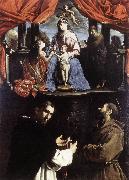 |
PAOLINI, Pietro
|
|
Italian painter, Lucchese school (b. 1603, Lucca, d. 1681, Lucca) |
|
 |
Paolo Alboni
|
|
(1671-1734), also called Paolo Antonio Alboni, was an Italian painter of the late-Baroque period. He was born and trained in Bologna, where he became a landscape painter. After practicing some time in Rome and Naples, he went in 1710 to Vienna, where he remained nearly thirteen years, but being deprived of the use of his right side by a stroke, he returned to Bologna; he subsequently painted with his left hand. His daughter, Luigia Maria Rosa, was also a landscape painter. She died in 1759.
|
|
|
|
 |
Paolo Antonio Barbieri
|
|
(1603-1649) was an Italian painter who was the brother of Guercino. He was born at Cento, a village near Bologna. The subjects of his pictures are flowers, fruit, and game, but he particularly excelled in painting fish |
|
|
|
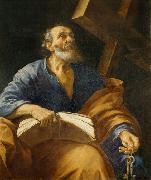 |
Paolo Emilio Besenzi
|
|
(1608-1656) was an Italian painter of the 17th century, born and active in Reggio. He trained with Francesco Albani. Friend and companion of Lionello Spada, he painted for the church of San Pietro. He was also known as sculptor and architect.
|
|
|
|
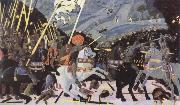 |
paolo uccello
|
|
(b Florence, c. 1397; d Florence, 10 Dec 1475). Italian painter, draughtsman, mosaicist and designer of stained glass. His work vividly illustrates the principal issues of Florentine art during the first half of the 15th century. Trained within the tradition of the Late Gothic style, he eventually became a leading exponent of the application of linear perspective based on the mathematical system established by Filippo Brunelleschi and Leon Battista Alberti. It is the merging of these two diametrically opposed tendencies that forms the basis of Uccello's style. As well as painting on panel and in fresco (many of his works in this medium have been severely damaged), he was also a master mosaicist and produced designs for stained glass.
|
|
|
|
|
|
|
|
|
|
|
|
|
|
|
|
|
|
|
|
|
|
|
|
|
|
|
|
 |
Pascal Dagnan-Bouveret
|
|
(January 7, 1852 - July 3, 1929), was one of the leading French artists of the academic school. He was born in Paris, the son of a tailor, and was raised by his grandfather after his father emigrated to Brazil. Later he added his grandfatheres name, Bouveret, to his own.
From 1869, he studied at the Ecole des Beaux-Arts under Alexandre Cabanel and Jean-Leon Gerôme. In 1873, he opened his own studio with a fellow student Gustave-Claude-Etienne Courtois. From 1875, he exhibited at the Salon, where in 1880 he won the first-class medal for the painting An Accident, and a medal of honour in 1885 for Horses at the Watering Trough.
From the 1880s, Dagnan-Bouveret along with Gustave Courtois, maintained a studio in Neuilly-sur-Seine, a fashionable suburb of Paris. By that time he was recognized as a leading modern artist known for his peasant scenes, but also for his mystical-religious compositions. His large-scale painting The Last Supper was exhibited at the Salon de Champ-de-Mars in 1896.[1] He also painted portraits for wealthy clients including the British collector George McCulloch. He was one of the first to use the then new medium of photography to bring greater realism to his paintings.
In 1891, he was made an Officer of the Legion of Honour; in 1900 he became a member of the Institut de France.
|
|
|











